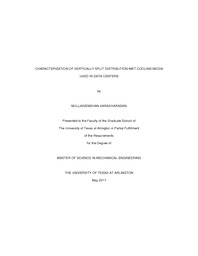
ATTENTION: The works hosted here are being migrated to a new repository that will consolidate resources, improve discoverability, and better show UTA's research impact on the global community. We will update authors as the migration progresses. Please see MavMatrix for more information.
Show simple item record
| dc.contributor.advisor | Agonafer, Dereje | |
| dc.creator | Varadharasan, Mullaivendhan | |
| dc.date.accessioned | 2017-07-03T16:10:40Z | |
| dc.date.available | 2017-07-03T16:10:40Z | |
| dc.date.created | 2017-05 | |
| dc.date.issued | 2017-05-24 | |
| dc.date.submitted | May 2017 | |
| dc.identifier.uri | http://hdl.handle.net/10106/26844 | |
| dc.description.abstract | Data Centers houses substantial number of information technology (IT) equipment like computer servers and storage modules associated with various electronic components which consume high volume of electricity. The IT equipment in data center housing keeps dissipates heat energy as it is constantly running day and night. To keep the data center environment under thermally control and to favor the reliability of electronic components, we need to adopt a cooling technique which aids the module level cooling, with due consideration of the size of the data center and its geographical location.
One of the adopted cooling technique in data center thermal management is direct evaporative cooling (DEC). In this DEC, warm air interacts with cold water and losses its sensible heat, thereby the temperature of the air be lowered and its relative humidity be increased.
Evaporative Cooling Pad or Wet Cooling Media is a rigid media in DEC technique, which plays a role to make air-water interaction more efficient. This thesis is focused on investigation on performance characteristics of a vertically split wet cooling media which has separate water distribution setup, this type of staged wetting gives more control on relative humidity (RH) as well as temperature.
In this study, commercial designing and CFD tools are used to design the wet cooling media and simulate the conditions for the test. I have used equal and un-equal two split configurations to test wet cooling media to check which configuration favors the control. Apart from relative humidity and temperature, other parameters of interests are pressure drop across the media and saturation efficiency of the rigid media. Each split configuration is further tested for different wetting, for equal configuration the media has been tested for 0%, 50% and 100%, similarly for unequal configuration the media has been tested for 0%, 33%, 66%, and 100%. The CFD model is further validated with the team’s previous experimental data and the results are plotted for comparison on control over inlet RH and temperature to the data center housing. | |
| dc.format.mimetype | application/pdf | |
| dc.language.iso | en_US | |
| dc.subject | Data center | |
| dc.subject | Wet cooling media | |
| dc.subject | Evaporative cooling media | |
| dc.subject | Split distribution | |
| dc.title | CHARACTERIZATION OF VERTICALLY SPLIT DISTRIBUTION-WET COOLING MEDIA USED IN DATA CENTERS | |
| dc.type | Thesis | |
| dc.degree.department | Mechanical and Aerospace Engineering | |
| dc.degree.name | Master of Science in Mechanical Engineering | |
| dc.date.updated | 2017-07-03T16:12:48Z | |
| thesis.degree.department | Mechanical and Aerospace Engineering | |
| thesis.degree.grantor | The University of Texas at Arlington | |
| thesis.degree.level | Masters | |
| thesis.degree.name | Master of Engineering in Mechanical Engineering | |
| dc.type.material | text | |
Files in this item
- Name:
- VARADHARASAN-THESIS-2017.pdf
- Size:
- 2.032Mb
- Format:
- PDF
This item appears in the following Collection(s)
Show simple item record


